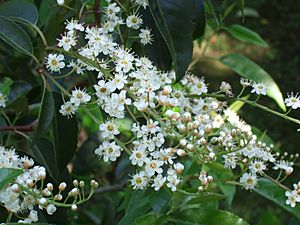Portuguese laurel cherry facts for kids
Quick facts for kids Portuguese laurel cherry |
|
|---|---|
 |
|
| Green leaves and young fruit | |
| Conservation status | |
| Scientific classification | |
| Synonyms | |
|
List
|
The Portuguese laurel cherry, also known as Portugal laurel (its scientific name is Prunus lusitanica), is a beautiful species of flowering plant. It belongs to the rose family called Rosaceae. This plant originally comes from places like southwestern France, Spain, Portugal, Morocco, and some islands in the Atlantic Ocean. These islands include the Azores, Canary Islands, and Madeira.
Scientists believe that the two main types (called subspecies) of this plant separated a very long time ago. This happened during a period called the Pliocene. One type is found in the Azores, and the other is found in the other areas.
Contents
About the Portuguese Laurel Cherry
The Portuguese laurel cherry is an evergreen plant. This means its leaves stay green all year round, even in winter! It usually grows as a shrub (a bushy plant) or a small tree. It can reach heights of 3 to 8 meters (about 10 to 26 feet). But if it's grown in a garden, it can sometimes grow much taller, up to 15 to 20 meters (about 50 to 65 feet)!
Its bark (the outer covering of the trunk and branches) is smooth and dark gray. The leaves grow in an alternating pattern along the stem. They are oval-shaped, about 7–15 cm (3–6 inches) long and 3–5 cm (1–2 inches) wide. Each leaf has a pointed tip and a slightly toothed edge. They are shiny dark green on top and lighter underneath. They look a bit like the leaves of the bay laurel plant, which is why people sometimes confuse them.
Flowers and Fruit
The flowers are small, about 10–15 mm (0.4–0.6 inches) across. They have five tiny white petals. These flowers grow in long clusters called racemes, which are 15–25 cm (6–10 inches) long. They appear in late spring.
The fruit is a small, cherry-like fruit called a drupe. It is about 8–13 mm (0.3–0.5 inches) in size. When it first appears, it is green or reddish-green. As it ripens in late summer or early autumn, it turns dark purple or black.
Where It Grows and Lives
The Portuguese laurel cherry is not very common in the wild. It is mostly found growing along mountain streams. It likes sunny places and soil that is moist but drains water well. It can handle some dry periods.
This plant can reproduce in two ways. It can reproduce sexually, which means from seeds. This is the most successful way. It can also reproduce asexually, by growing new plants from shoots that come from the original plant.
What's in a Name?
The famous scientist Carl Linnaeus first described this species in 1753 in his book Species Plantarum. The second part of its scientific name, lusitanica, means "of Lusitania." Lusitania was the old Roman name for Portugal.
Different Types (Subspecies)
There are three accepted types, or subspecies, of Prunus lusitanica:
- Prunus lusitanica subsp. lusitanica: This type is found in mainland Europe.
- Prunus lusitanica subsp. azorica (Mouill.) Franco: This type is found in the Azores islands.
- Prunus lusitanica subsp. hixa (Willd.) Franco: This type is found in the Canary Islands, Madeira, and Morocco.
Growing the Plant
The Portuguese laurel cherry is often grown as an ornamental plant. This means people plant it because it looks nice. It is widely used to create hedges and for screening in gardens and parks.
It has also spread and started growing on its own in some temperate areas. These include northern France, Great Britain, Ireland, New Zealand, parts of Western Canada, and the western United States (California, Oregon, and Washington State).
Some plant experts in western Washington and Oregon consider Prunus lusitanica to be an invasive plant. This means it can spread easily from gardens into natural areas. Birds eat the fruit and then drop the seeds in new places, helping the plant spread.
This plant has received the Royal Horticultural Society's Award of Garden Merit. This award recognizes plants that are excellent for gardening.
Safety Information
The leaves of the Portuguese laurel cherry contain a substance that can release cyanide. This means they should not be burned or crushed, as it could release harmful chemicals into the air.
The fruit is somewhat safe to eat if it is fully ripe. However, if the fruit tastes bitter, it is not safe and should not be eaten. It's always best to be careful and avoid eating parts of plants you are not sure about.
See also
 In Spanish: Prunus lusitanica para niños
In Spanish: Prunus lusitanica para niños




